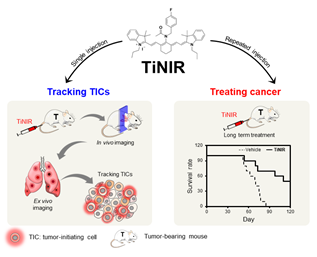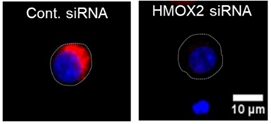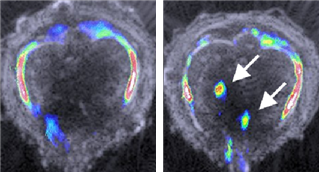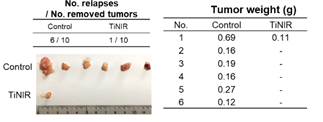글로벌 연구동향
분자영상 및 방사화학
- 2019년 11월호
[J Am Chem Soc.] A Near-Infrared Probe Tracks and Treats Lung Tumor Initiating Cells by Targeting HMOX2.포항공대 / 김종진, 이용안, 장영태*, 강남영*
- 출처
- J Am Chem Soc.
- 등재일
- 2019 Sep 18
- 저널이슈번호
- 141(37):14673-14686. doi: 10.1021/jacs.9b06068. Epub 2019 Sep 4.
- 내용

그림1) A novel TIC probe TiNIR, which targets to HMOX2 in the tumor was developed and showed its feasibility as a tracking and therapeutic tool for lung cancer.

그림2) Target identification of TiNIR. Confirmation of TiNIR target by treatment of HMOX2 siRNA.

그림3) In vivo imaging of lung tumor metastasis mouse by MSOT (multispectral optoacoustic tomography).

그림4) Therapeutic effect of TiNIR on the lung cancer. Inhibition of tumor relapse by TiNIR. To check the relapse of the tumor, TS32 cells were injected into the flank site of NSG mice. Tumor tissues were removed by surgery in anesthesia by ketamine (40mg/kg) /xylazine (10mg/kg). From day 1 after post-surgery of tumors, TiNIR (100 μM) was injected into tail vein (200 μL/mouse) every couple of days until day 27.
Abstract
Tumor initiating cells (TIC) are resistant to conventional anticancer therapy and associated with metastasis and relapse in cancer. Although various TIC markers and their antibodies have been proposed, it is limited to the use of antibodies for in vivo imaging or treatment of TIC. In this study, we discovered heme oxygenase 2 (HMOX2) as a novel biomarker for TIC and developed a selective small molecule probe TiNIR (tumor initiating cell probe with near infrared). TiNIR detects and enriches the functionally active TIC in human lung tumors, and through the photoacoustic property, TiNIR also visualizes lung TIC in the patient-derived xenograft (PDX) model. Furthermore, we demonstrate that TiNIR inhibits tumor growth by blocking the function of HMOX2, resulting in significantly increased survival rates of the cancer model mice. The novel therapeutic target HMOX2 and its fluorescent ligand TiNIR will open a new path for the molecular level of lung TIC diagnosis and treatment.
Author informationKim JJ1,2, Lee YA1,3, Su D1, Lee J4, Park SJ1, Kim B1, Jane Lee JH3,5, Liu X2, Kim SS6, Bae MA6, Lee JS7, Hong SC7, Wang L1,8, Samanta A1,9, Kwon HY2, Choi SY, Kim JY10, Yu YH11, Ha HH11, Wang Z3, Tam WL3,12,13, Lim B3,14, Kang NY1,4, Chang YT1,2.
1
Laboratory of Bioimaging Probe Development, Singapore Bioimaging Consortium, Agency for Science , Technology and Research (A*STAR) , Singapore 138667 , Singapore.
2
Center for Self-assembly and Complexity , Institute for Basic Science (IBS) , Pohang 37673 , Republic of Korea.
3
Genome Institute of Singapore, Agency for Science , Technology and Research (A*STAR) , 60 Biopolis Street , Singapore 138672 , Singapore.
4
New Drug Discovery Center , DGMIF , Daegu 41061 , Republic of Korea.
5
School of Biological Sciences , Nanyang Technological University , Singapore 637551 , Singapore.
6
Bio & Drug Discovery Division , Korea Research Institute of Chemical Technology , Yuseong-Gu , Gajeong-ro 141 , Daejeon 34114 , Republic of Korea.
7
Molecular Recognition Research Center , Korea Institute of Science and Technology , 5, Hwarang-ro 14-gil , Seoul 02792 , Republic of Korea.
8
Department of Chemical Biology , Max Planck Institute for Medical Research , Heidelberg 69120 , Germany.
9
Chemical Sciences and Technology Division , CSIR - National Institute for Interdisciplinary Sciences and Technology (CSIR - NIIST) , Industrial Estate P O , Pappanamcode , Thiruvananthapuram 695019 , India.
10
A-fourth, SL VAXiGEN , KOREA BIO PARK , Daewangpangyo-ro 700, Bundang-gu , Seongnam-si , Gyenggi-do 13488 , Korea.
11
Department of Pharmacy, and Research Institute of Life Pharmaceutical Sciences 11 , Sunchon National University , Suncheon 57922 , Republic of Korea.
12
Cancer Science Institute of Singapore , National University of Singapore , Singapore 117599 , Singapore.
13
Department of Biochemistry, Yong Loo Lin School of Medicine , National University of Singapore , Singapore 117597 , Singapore.
14
Merck Sharp and Dohme Translational Medicine Research Centre , 8A Biomedical Grove , Singapore 138648 , Singapore.
- 연구소개
- 종양근원세포 (Tumor initiating cell, TIC)는 항암치료에서 저항성을 나타내며, 암의 재발 및 전이를 유도합니다. 다양한 방법으로 TIC를 추적하고 치료하고자 하지만 제한된 접근성과 정상 줄기세포와 유사성 때문에 한계가 있습니다. 본 연구에서 Diversity Oriented Fluorescence Library Approach (DOFLA)를 이용하여 TIC를 추적하는 근적외선 영역의 형광 탐침자 (TiNIR)를 개발하였으며, 이와 결합하는 TIC 특이적인 바이오마커 단백질, HMOX2를 발굴하였습니다. HMOX2 발현조절 실험을 통하여 본 단백질이 TIC에서 ROS 소거에 중요한 단백질임을 확인하였고, 고농도의 TiNIR가 HMOX2를 억제하여 세포사멸을 유도한다는 것을 확인하였습니다. 결과적으로 독성이 낮은 농도의 TiNIR는 TIC를 추적 및 분리를 할 수 있으며, 고농도 및 반복적인 투여로 암을 치료할 수 있다는 것을 확인하였습니다. 새로운 바이오마커과 이를 추적 및 억제하는 탐침자에 의해 암의 치료와 진단에 새로운 가능성을 열어주는 성과입니다.
- 덧글달기







